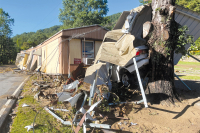Opt-In meetings gather public input on future needs
How would you spend $800 million?
Residents and opinion leaders from the seven westernmost counties and the Qualla Boundary have just completed a series of input sessions design to gather broad-based feedback to help answer just that question.
The state and federal highway departments are paying $1.3 million for the Opportunity Initiative, or Opt-In, which aims to craft a regional vision for Western North Carolina. The outcome of Opt-In will decide whether the state will finally construct a controversial four-lane highway called Corridor K through Graham County or spend its millions on a re-envisioned transportation plan for the region.
“People couldn’t agree,” said Woody Giles, assistant project manager with TSW, the consulting firm hired for Opt-In. “We need to zoom out and think about the bigger region.”
TSW led six public input sessions, including one in Cherokee and another in Haywood County, during the last three weeks to talk about what it is describing as “five pillars:” the places we’re given; the economy we need; the places we make; the ways we get around; and the quality of life we expect.
Related Items
“The effort is very timely,” said Larry Blythe, vice chief of the Eastern Band of Cherokee Indians, pointing to the possibility of expanding the airport runway in Andrews to accommodate the new casino the tribe is building near Murphy. “These are things we want to see continue — the beauty of the region, economic opportunities, better transportation.”
However, at the Haywood County meeting, participants were leery of the impact that the tribe’s new casino would have on the region and wondered whether it would it be a good thing for everyone.
“Encourage the proposed casino to be a positive impact on the region,” said Waynesville Town Manager Marcy Onieal, suggesting that the group write that down as a goal.
The regional vision plan must allow for development but also respect the land and historic Cherokee sites. In the past, it has seemed like a one or the other option.
“It is either protect them and nobody has access, or they have to open the gate and let in the store,” said Lynne Harlan, an enrolled member and head of media relations for the tribe. “Have limits so we aren’t depleting these resources.”
Attendees at the Haywood County input session stated that zoning regulations could help strike a balance between development and maintenance of natural resources.
The emphasis of the input sessions was on creating a regional identity, which could be tough for the subareas of Western North Carolina that have focused most of their time carving out a county-by-county niche. However, there is at least one major element that binds everyone together — a rural environment that is quieter than say Gatlinburg or Pigeon Forge.
“We are not as developed as Asheville, which is good,” said Mark Clasby, Haywood County’s economic development director.
But people at the meetings were not exactly sure what the best way to take advantage of being “the quiet side of the Smokies.”
Another marketable tool is Cherokee history, which can be found all over WNC. The region could work together, with direction from the Eastern Band, to promote various historic Cherokee sites, said Cory Blankenship, treasury director at Eastern Band.
“I think it is important for county leaders and city leader to look for the Eastern Band for guidance,” Blankenship said. “We would like to be consulted on those things.”
But if there is not an easy way for people to get around, then having attractions is a bit of a moot point.
“The problems that we face in this area are because of our remoteness and how we are set up here,” said Barak Myers, head of Cherokee Department of Transportation. “There is not an easy way to get from here to Sylva.”
Myers said that the region also needs to focus on bolstering downtown areas with continuous sidewalks and bike lanes for tourists to easily get around.
Onieal expressed a similar sentiment at a different input session.
“I think downtown is what is going to capture people,” Onieal said.
“If we want to maintain our character and we acknowledge growth will happen, then we need to focus our growth on the already dense areas, meaning growing our towns,” she later added.
A lack of public transportation impacts residents and jobseekers as well. People at both the Opt-In meetings in Cherokee and Haywood County expressed a desire for some type of county-to-county transit.
People travel all the way from Asheville for a job at the casino but end up quitting because of the long commute, said Kathy Littlejohn, manager of public transit for the tribe. Littlejohn has even seen locals staying in hotels because there are not adequate transportation options around the region.
“You have the economic development, and it helps tremendously in your community and surrounding communities, but over time the work force is not as great as the need is,” Littlejohn said.
By extension, Blythe said there is also a need for more affordable housing options. If those were available, people who work at the casino could possibly move closer.
What is Corridor K?
Corridor K is the missing 18-mile piece of an Appalachian highway that the state started building 50 years ago.
The four-lane highway would connect the seven western counties and create an efficient way to travel amongst their peaks and valleys – the goal being to bring greater economic prosperity to the secluded and economically depressed regions of Western North Carolina.
Every other piece is complete except for the section of highway in Graham County that would go through Stecoah to Robbinsville and out to Andrews. The last stretch stalled after meeting with opposition because it is the steepest, most expensive and potentially most environmentally damaging part of the highway.
Now, the N.C. Department of Transportation and the Federal Highway Administration are investigating alternative, non-controversial transportation plans that could still meet the needs of the region.









